Why GenAI Projects Fail – and What It Takes to Rethink Enterprise Data Architecture
Why 95% of GenAI Projects Fail—And How Articul8’s Autonomous Data Perception Delivers Real-time ROI on Day 1
Only 5% of GenAI projects succeed in production. Why? Because most enterprises are using pre-2020s tools to solve 2030s problems. This blog breaks down where the real bottlenecks are – and how Autonomous Data Perception, powered by Articul8’s self-evolving hybrid graph + vector architecture, can unlock real-time ROI at scale.
The Industry Problem: Why GenAI Isn't Scaling
Across industries, GenAI pilots launch with high expectations. But as organizations dig in, they realize a problem: GenAI is easy to pilot, but finding ROI through consistent repeatable processes remains elusive. Industry estimates suggest fewer than 5% of GenAI initiatives transition successfully to production. While the industry focuses on models and prompts, the true barrier lies in a fundamental misalignment between modern AI systems and legacy enterprise data architectures.
Enterprise data environments are deeply entrenched in rigid legacy structures. These infrastructures were designed with legacy functions such as reporting and compliance in mind, not GenAI. As a result, GenAI tools trained to synthesize meaning and draw connections must navigate flat (or incorrect) schemas and disjointed data.
Without access to semantically connected, context-rich data, even the most advanced GenAI systems are forced to operate like blindfolded analysts – excellent at language but starved for relevant information. This is why large-scale enterprise GenAI projects continue to struggle to deliver ROI. Legacy infrastructure constrains GenAI, reducing it to a simple query-answering tool. These systems lack what customers seek: the capacity to interpret context, anticipate user intent, or generate strategic solutions. In other words, they can report the “what” but never explain the “why” or “what next.”

Why Flat Architectures Fail in High-Stakes Industries
Complex industries such as telecommunications, financial services, energy, and aerospace particularly feel the impact of limitations from flat data architectures. These sectors depend on deeply interrelated entities:
- Telecom: routers, switches, IPs, devices, and users
- Energy: infrastructure, test results, compliance reports, historical anomalies
- Financial services: instruments, accounts, clients, trades, regulations
- Aerospace: parts, suppliers, certifications, failure logs
Flat architectures break these relationships apart, forcing manual reconciliation, redundant metadata, and error-prone analysis. That means missed risks, slow root-cause analysis, and compliance failures. They can't model multi-level connections, making queries like, "show all components involved in repeated system failures across similar test conditions" nearly impossible to execute reliably.
Why Knowing the “Shape of your Data” Matters
“Shape” of your data isn’t about appearance – it’s a core requirement for intelligent reasoning.
Real-world systems, such as networks, supply chains, regulatory frameworks, aren’t rows and columns. They’re graphs – dynamic, interconnected, multi-layered.
An autonomous knowledge graph encodes these relationships, allowing GenAI to move beyond “what happened” to “why” and “what’s related.”
Imagine diagnosing a system outage or a product recall. Without relational context, you’re stuck combing through logs. With a knowledge graph, you can query: “Which suppliers share components across systems with similar anomalies?” – and get answers in milliseconds. Because the system understands intent, it autonomously gathers and interprets the data without the need for follow-up queries with step-by-step instructions.
To make GenAI useful at enterprise scale, we must stop training intelligence on tabular noise. The future is autonomous and graph-shaped.
Network Intelligence at Scale: From Static Logs to Living Digital Twins
As network complexity surges – via 5G, IoT, and multi-cloud – traditional logs and metrics fall short. Enterprise customers don’t just need uptime – they need real-time, relationship-aware visibility. They need to know what changed, why, and what it affects downstream.
That’s why Articul8 developed Weave, the Network Topology Agent – a living digital twin of your network. Weave autonomously transforms logs, config files, and topology diagrams into a real-time, autonomous semantic knowledge graph of your entire infrastructure.
Unlike static dashboards, an autonomous knowledge graph captures not just devices and events, but the contextual relationships between them:
- Temporal and Context Linking: Correlate changes across time windows to pinpoint when and why issues emerge.
- Entity Resolution: Stitch together disparate data sources – logs, configs, and topology diagrams into a unified, queryable representation of the network.
- Subgraph Extractions: Enable focused insights on VLANs, VRRP peers, or IP associations without parsing through thousands of nodes manually.
- Learning from Past Troubleshooting: Identify patterns by comparing current incidents with historically similar network configurations to accelerate RCA and establish best practices.
It’s not just observability – it’s autonomous topology intelligence.
VLAN Network
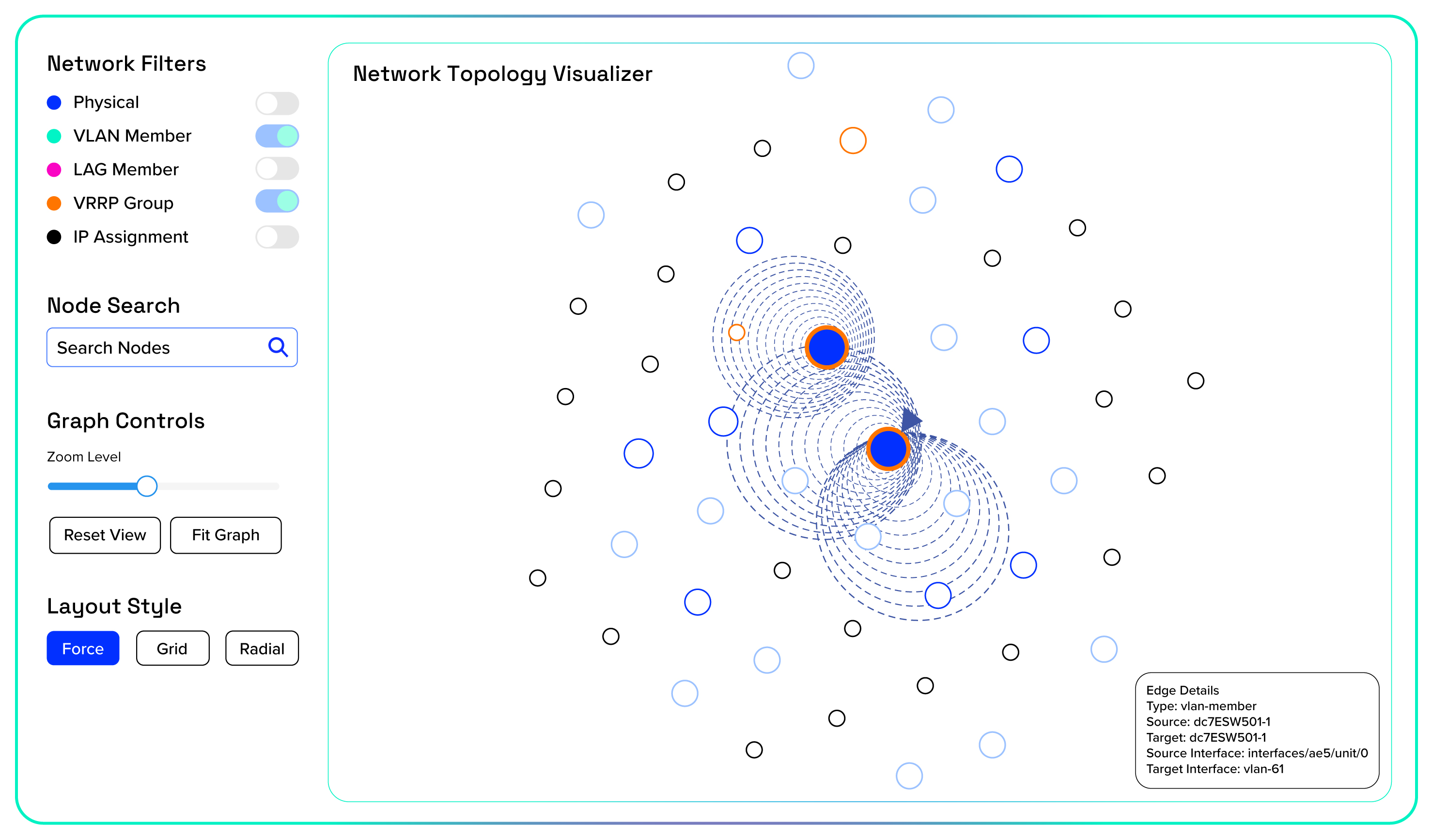
IP Address
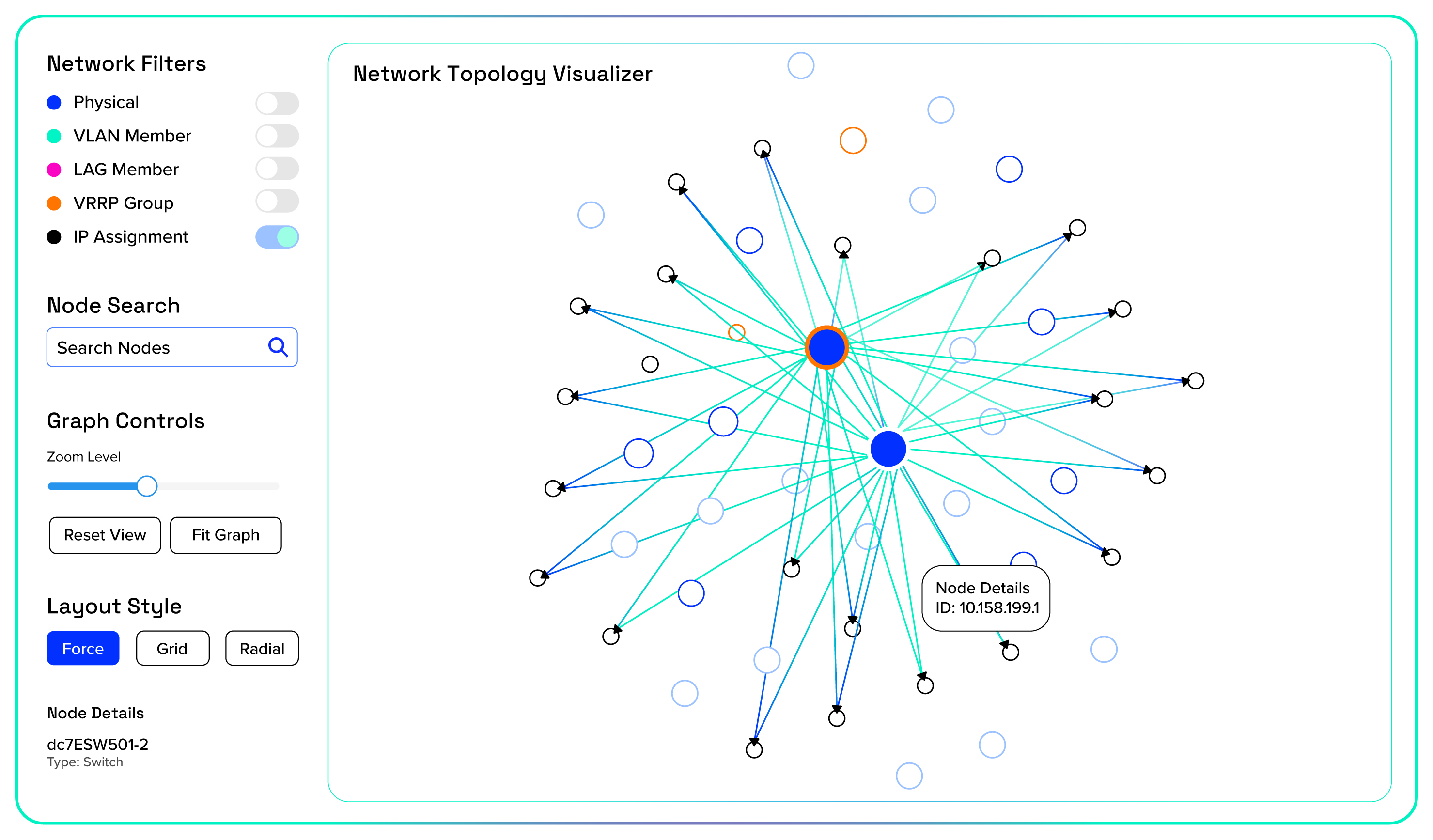
Multiple Layouts
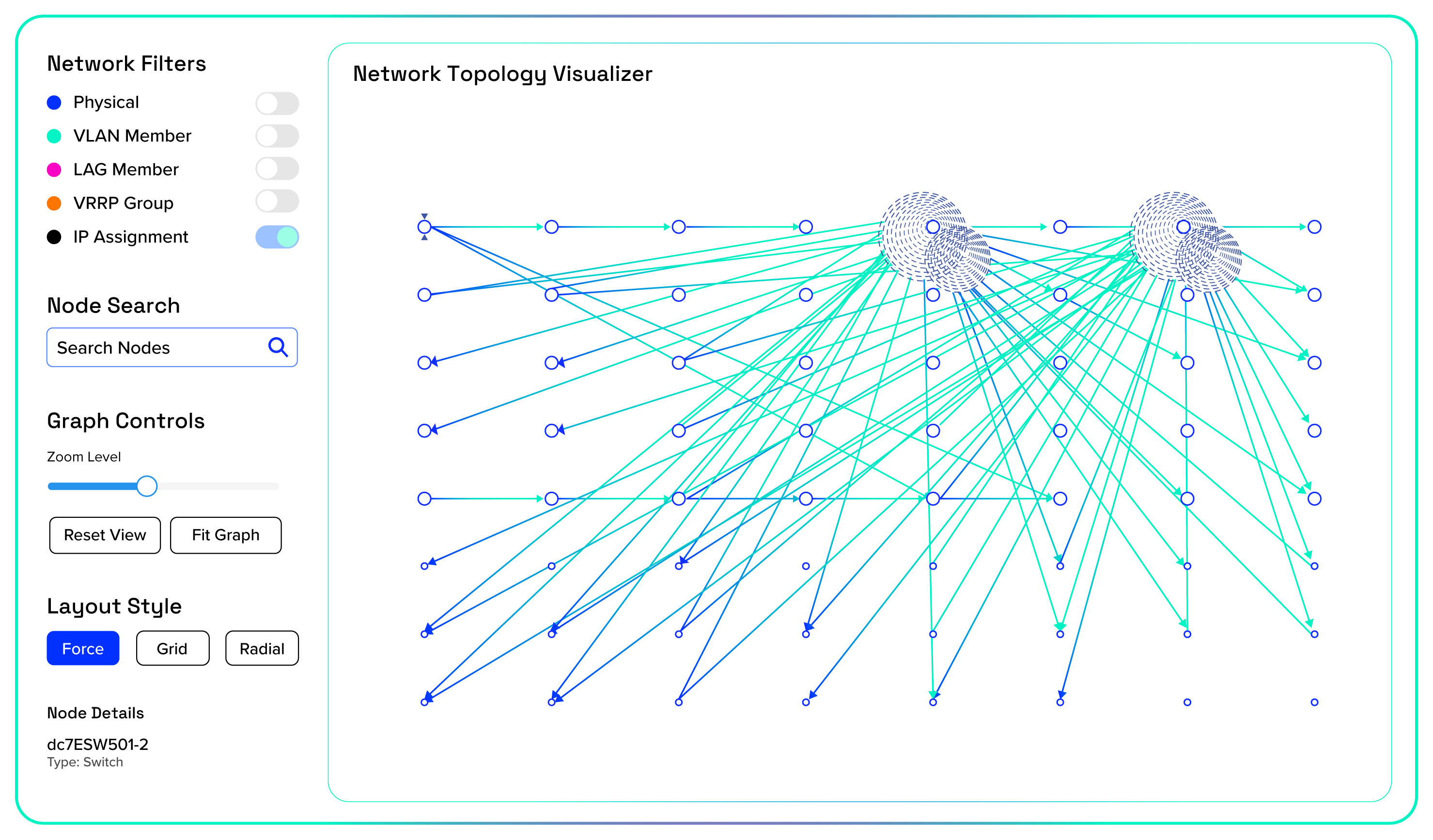
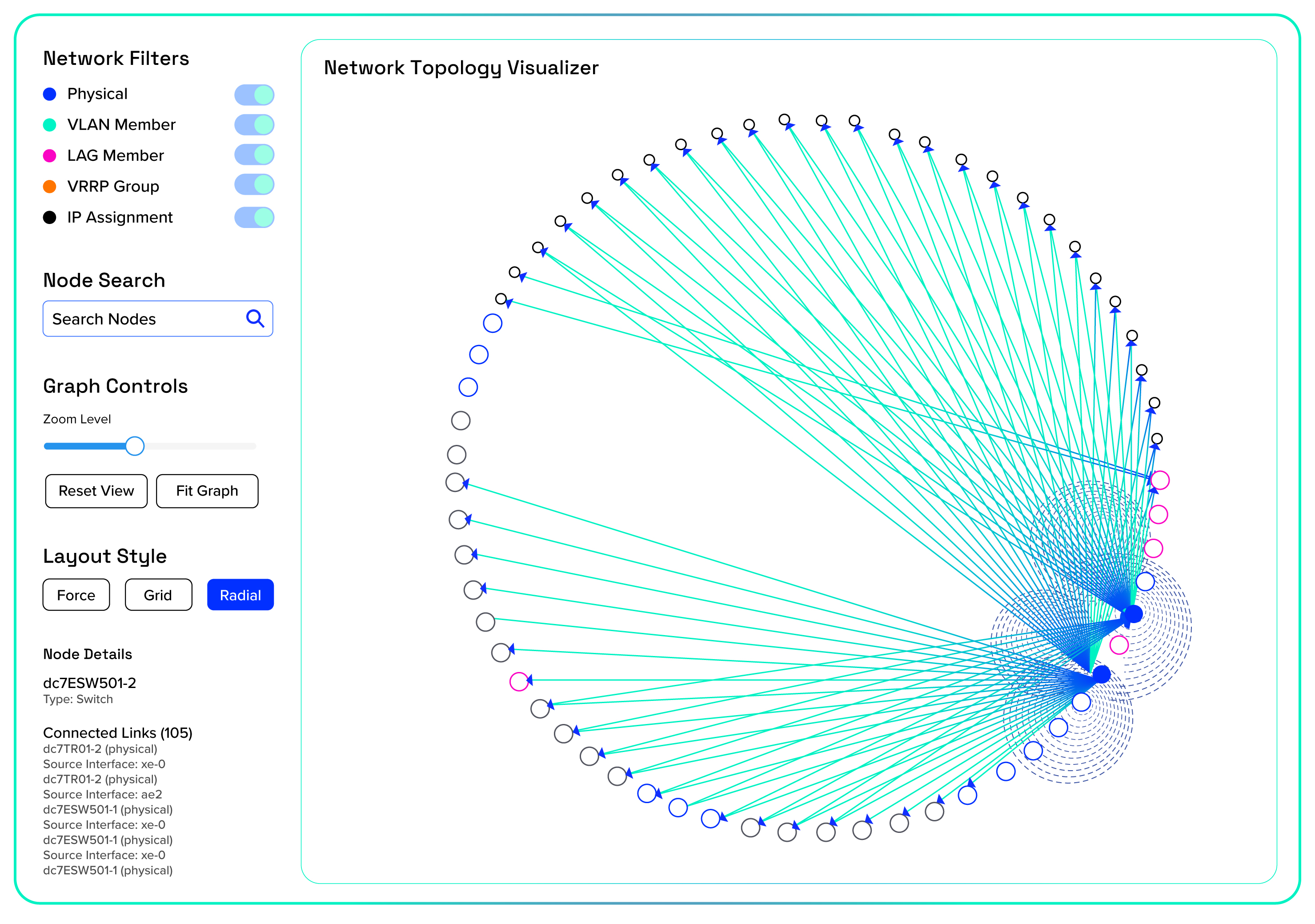
How it Works
Weave ingests a customer’s network logs, config files, and topology diagrams, then constructs a semantic knowledge graph reflecting routers, switches, cloud instances, and cross-service dependencies in real time. This enables:
- Root Cause Analysis: Trace cascading failures across thousands of edges and isolate the root event.
- Zero-Trust Enforcement: Detect and audit unexpected flows between internal systems.
- Multicloud Drift Monitoring: Compare topology snapshots over time, flagging unexpected external edges or cross-cloud misconfigurations.
- Change Planning: Simulate the impact of routing or VLAN reassignments using comparative subgraph analysis before deployment.
How it's used in the field
A global SaaS company feeds Weave fresh NetFlow data nightly into isolated filegroups. The autonomous Knowledge Graph (~6,000 nodes, ~8,000 edges) is compared to yesterday’s version. Any unauthorized outbound flows are flagged and piped directly into their zero-trust enforcement engine. This unified approach ties security, observability, and compliance into a single living graph.
This topology intelligence is consumable via API, not just UI, enabling programmable, agent-based network awareness that integrates with CI/CD pipelines, nightly jobs, and policy engines. This is the foundation for resilient, autonomous infrastructure in a multicloud world.
Engineering Real-Time Intelligence: EPRI's Shift to a Graph-Native Knowledge Architecture
The Electric Power Research Institute (EPRI) faced the exact challenge of flat architectures. Their knowledge base included 10,000+ historical documents – engineering reports, test logs, maintenance manuals, tables, and scanned PDFs: vast but siloed. Manual analysis across this content was inefficient and inconsistent.
Partnering with Articul8, EPRI launched a knowledge re-architecture initiative. The first milestone: ingest, process, and interconnect their full document corpus into an autonomous knowledge graph. In under 12 hours, Articul8 successfully ingested over 10,000 documents into a multimodal autonomous knowledge graph, with a < 1% failure rate, including scanned and semi-structured content.
The resulting graph linked over 4 million entities, including:
- 400,000 image nodes
- 230,000 table nodes
- Thousands of edges denoting logical ("contains", "references") and semantic ("related to") relationships identified autonomously
This platform architecture now powers a real-time research and discovery tool being tested by EPRI scientists. Instead of skimming PDFs or guessing keyword matches, energy customers can traverse relationships across reports, trace topic clusters, and surface relevant citations in milliseconds.
Business Outcome: From ingestion to insight in under 12 hours. Sub-1% failure rate. Instant adoption. Built for real-world scale.
Beyond Vector Databases: Articul8's Autonomous Hybrid-Knowledge Graph Architecture
While vector databases excel at fast similarity searches (~20ms per query) for moderate workloads, performance drops at scale beyond 10 million records, with latency increasing to ~200ms. Even advanced Hierarchical Navigable Small World (HNSW) indexes can't overcome this limitation: vector databases cannot model relationships between data sources due to their flat structure.
Today's enterprise applications require more than just fast lookups—they need deep contextual understanding to extract meaningful insights.
This is why Articul8's platform was designed with a heterogeneous, hybrid architecture. By incorporating robust graph capabilities, we enable complex contextual queries such as:
"Which systems experienced cascading failures linked to similar input patterns?"
The Hybrid Architecture: Optimizing Data Storage for Performance and Context
This integration leverages graph traversal and relationship modeling alongside search capabilities.
Each component performs its specialty: vector database handles vector operations while graph database manages relationship networks, and key-value stores take care of latency-sensitive storage, in addition to object and other stores, everything linked through metadata in the knowledge graph. The result is a unified platform that maintains performance and data integrity while scaling to meet enterprise demands.
In today's data-rich enterprise landscape, interpreting information through logical and semantic data connections is essential for generating insights and driving business success.
Our system autonomously recognizes and builds multiple connections: logical connections (structured, rule-based relationships like customer-order links) and semantic connections (contextual relationships that understand "automobile" and "car" refer to the same concept).
Through these connections, customers gain a deeper, more accurate understanding of their data environment, which we call Autonomous Data Perception.
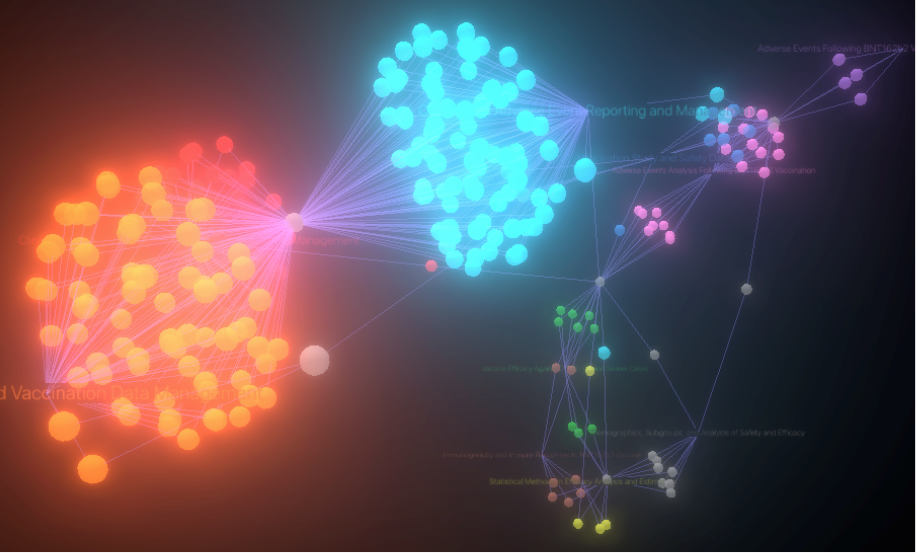
What Comes Next: A Call to Action for Industry
Scaling GenAI isn’t just about adding new tools – it’s about overhauling the underlying architecture to meet the demands of real-time intelligence. Our continued evolution of the Autonomous Data Perception capability is a blueprint for how enterprises can operationalize GenAI at scale.
We’re advancing three critical imperatives for industry leaders through Autonomous Data Perception:
- Autonomous multi-modal knowledge extraction to unify unstructured data search and inference workflows
- Advanced clustering and semantic topic detection to uncover latent insights and streamline decision-making
- Secure, multi-tenant deployments designed for regulated industries like aerospace, energy, and finance
These capabilities aren’t future nice-to-haves, they are foundational requirements for any enterprise customers serious about using GenAI to drive value across complex systems.
The challenge ahead for most organizations isn’t about choosing the best model – it’s about re-engineering the substrate where intelligence happens. That means replacing brittle pipelines with dynamic knowledge infrastructure, connecting information across modalities, and enabling reasoning across the enterprise.
Flat data is yesterday’s problem. Today, GenAI enables an architecture that can learn, reason, and relate.
The enterprises that win with GenAI won’t just prompt better – they’ll architect better.
Ready to transform your enterprise data into actionable insights? Contact us today to learn how Articul8 can help your organization harness the power of intelligent knowledge graphs.